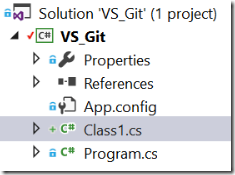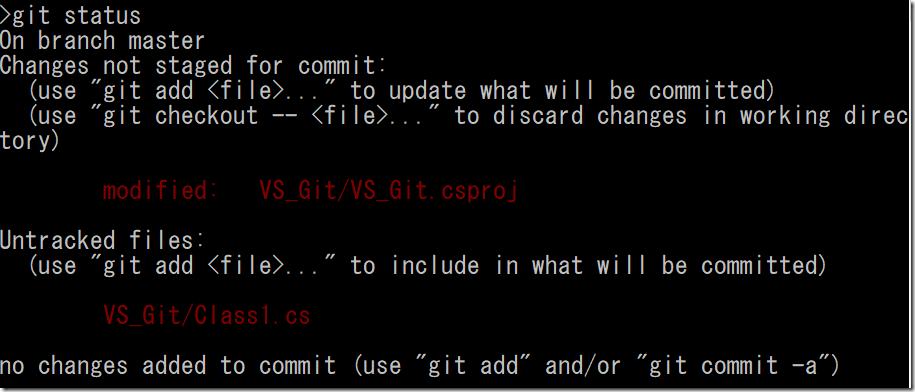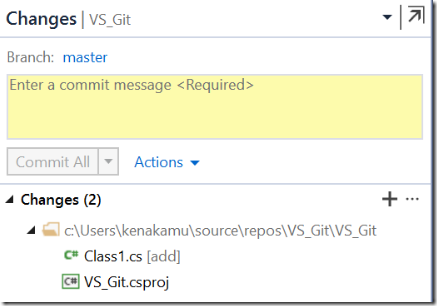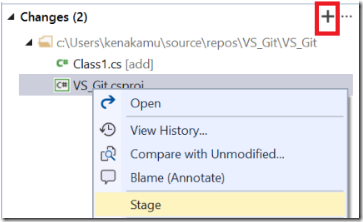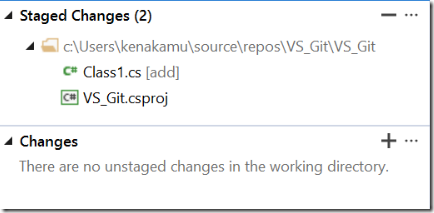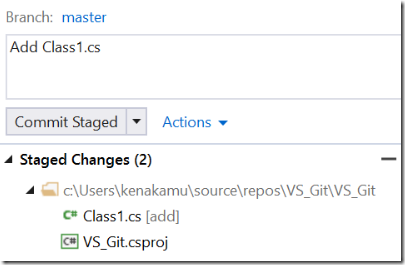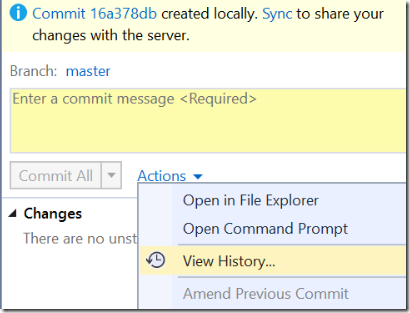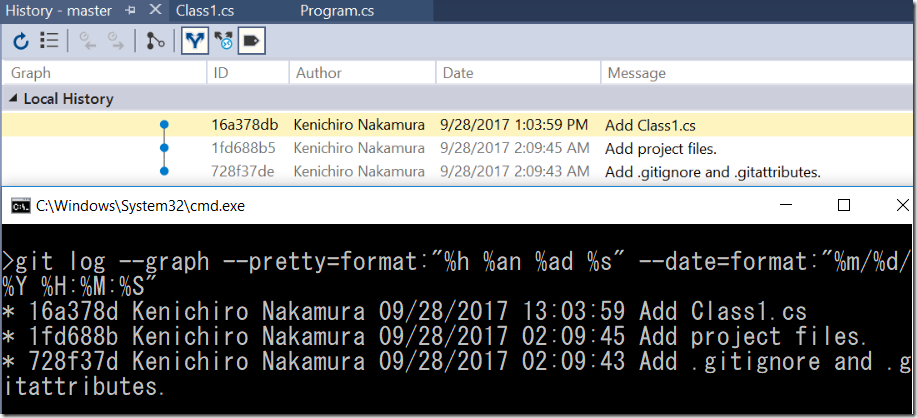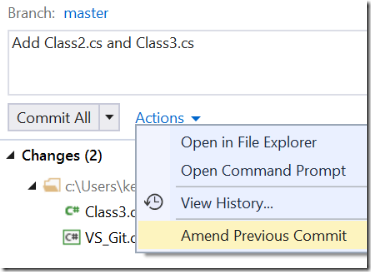Git and Visual Studio 2017 part 2 : Saving your solution
In previous article, we started Git repository. In this article, let’s see how Visual Studio add and commit your solution.
Adding items
What will happen when we add items such as class file into the project? Let’s try.
1. Right click the project and add class file called “Class1.cs”
2. In Solution Explorer Class1.cs has[+] icon, which indicates the file is added but not tracked. VS_Git project has red check icon, which indicates tracked and modified. Open command prompt and run ‘git status’, too. As .csproj file once tracked, Git sees the change and says its modified but not staged. The newly added Class1.cs, on the other hand, marked as untracked file.
Stage items
We already know that ‘git add’ will stage them. I use Visual Studio this time.
1. Right click the project and select Source Control | Commit. This won’t commit the change but navigates you to Changes pane.
2. You see there are two changes.
3. Click [+] button in Stages area will “stage” these changes. You can do it one by one by right click each item.
4. Then you see items are moved to Staged area. Run ‘git status’ to double check it. By clicking [-] or from right click context menu, you can un-stage items.
Commit items
Finally, time to commit.
1. Enter commit message and click “Commit Staged”.
2. You see SHA1 hash for the commit as a result. Ignore ‘Sync’ thing at the moment. Click “Actions” and select “View History”.
3. History is equivalent to ‘git log’ command. Run ‘git log --graph --pretty=format:"%h %an %ad %s" --date=format:"%m/%d/%Y %H:%M:%S"’ to compare the result.
Commit variations
There are several commit variations.
commit -a -m
This is quite normal workflow then using VS, that you directly commit by skipping staging items.
1. Add another class “Class2.cs”, and select commit from context menu same as you did above.
2. Enter commit comment and click “Commit All”. This will issue ‘git commit -a -m’ command.
3. Check history.
The amend option is important when you forget to add some changes to previous commit. By using this you can add those changes as part of previous commit.
1. Add another class “Class3.cs” and select commit from context menu same as you did above.
2. Enter commit comment. Click “Actions” and select “Amend Previous Commit”. This immediately issue ‘git --amend’ command.
3. View log to see if it worked as expected.
Once thing to note is that you see SHA1 hash value is different from previous commit. This is because commit object has been updated thus it becomes different object.
Summary
git add, commit and log are very straight forward, so I guess this was a bit easy. I will go deeper in the next article by explaining how to reset and restore. Go to next article.
Ken
Comments
- Anonymous
October 02, 2017
Hi Nakamura san, In the section of Commit items, item number 3, it should be 'git log --graph --pretty=format:"%h %an %ad %s" --date=format:"%m/%d/%Y %H:%M:%S"'. BTW, it's Summary instead of Summery. Thank you for your blog, This tutorial improve my understanding with the git command.Regards,Rui- Anonymous
October 02, 2017
Thanks! I fixed the "Summary" :) The log command looks same? if you mean two dash for option, it shows as one dash by some reason...- Anonymous
October 03, 2017
Hi Nakamura san,Right! You are correct! It is seem like the issue of the blog. The blog only show up one dash. Maybe it is some sort of escape sequence?---Regards,Rui
- Anonymous
- Anonymous
- Anonymous
October 07, 2017
Hi!Two cents to add: there is some confusing (still logical) situation when:1) a new file is added (or existing one is modified),2) then the file is staged,3) then the file content was changed again - before committing.In this case, the file will be mentioned twice - both in "git status" and VS's Changes window.I wish VS would warn the developer on committing staged changes if there is new edition of the file.- Anonymous
October 07, 2017
Yes you are right. I did cover the scenario at part 8 (https://blogs.msdn.microsoft.com/kenakamu/2017/10/04/git-and-visual-studio-2017-part-8/). While I agree that it is nice feature that VS lets us know there are newer modified file in working directory, I also believe this is how Git and VS should work anyway from granular committing idea. I even want VS to support git add -p scenario, which VSCode does. I know we already know why this happens, as Git keeps the content when we issue 'git add' command, as I explained in part 1. Thanks a lot anyway that you brought your good experience up here, which benefit us all :)
- Anonymous

